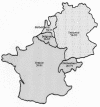Study of genotypes and virB4 secretion gene of Bartonella henselae strains from patients with clinically defined cat scratch disease
- PMID: 15070983
- PMCID: PMC387542
- DOI: 10.1128/JCM.42.4.1420-1427.2004
Study of genotypes and virB4 secretion gene of Bartonella henselae strains from patients with clinically defined cat scratch disease
Abstract
Bartonella henselae is the causative agent of cat scratch disease (CSD), which usually presents as a self-limiting lymphadenopathy. Occasionally, the bacteria will spread and be responsible for tissue and visceral involvement. Two B. henselae genotypes (genotypes I and II) have been described to be responsible for uncomplicated CSD on the basis of 16S rRNA sequence analysis. A type IV secretion system (T4SS) similar to the virulence-associated VirB system of Agrobacterium tumefaciens was recently identified in the B. henselae Houston-1 genotype I strain. We studied the correlations of the B. henselae genotypes with the clinical presentations and with the presence of T4SS. Isolates originated from CSD patients whose lymph nodes were prospectively analyzed. B. henselae genotype I was identified in 13 of 42 patients (30%). Among these, two teenage twins presented with hepatosplenic CSD and one immunocompetent adult presented with osteomyelitis. Genotype II was detected in 28 of 42 patients (67%), all of whom presented with uncomplicated CSD. The last patient was infected with both genotypes. T4SS was studied by PCR amplification of the virB4 gene. Amplification of virB4 codons 146 to 256, 273 to 357, and 480 to 537 enabled us to detect 66, 90, and 100% of the B. henselae isolates, respectively. Sequence analysis revealed sequence variations that correlated with genotype distribution. Our studies suggest that B. henselae genotype I strains harbor virB4 genes that are different from those harbored by genotype II strains and that genotype I strains might be more pathogenic.
Figures


References
-
- Anderson, B., D. Jones, and A. Burgess. 1996. Cloning, expression and sequence analysis of the Bartonella henselae gene encoding the HtrA stress-response protein. Gene 178:35-38. - PubMed
-
- Arisoy, E. S., A. G. Correa, M. L. Wagner, and S. L. Kaplan. 1999. Hepatosplenic cat-scratch disease in children: selected clinical features and treatment. Clin. Infect. Dis. 28:778-784. - PubMed
-
- Bass, J. W., J. M. Vincent, and D. A. Person. 1997. The expanding spectrum of Bartonella infections. II. Cat-scratch disease. Pediatr. Infect. Dis. J. 16:163-179. - PubMed
Publication types
MeSH terms
Substances
Associated data
- Actions
LinkOut - more resources
Full Text Sources
Other Literature Sources
Medical
Molecular Biology Databases
Miscellaneous

